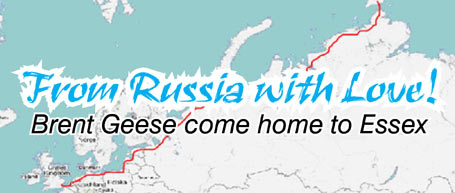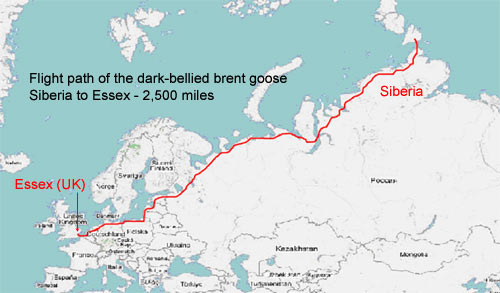Brent Geese - Healthy Life Essex
Home » Articles » Outdoor Life » Wildlife » Birds » Brent Geese

What are they?
A small goose, slightly larger than a mallard. It is dark with a black head and neck and grey-brown back, with either a pale or dark belly, depending on the race. It has a bright white  patch, and so do many of the young birds when they arrive in Leigh. (NB. Young birds look very similar to adults by the time they arrive in the UK, but retain their striking white wing-bars). It flies in loose flocks along the coast, rather than in tight skeins like grey geese. It is an Amber List species because of the important numbers found at just a few sites. It is often seen flying in ‘V’ formation over Leigh between feeding sites. Their winter weight is around 1300-1600g, but by the time they are ready to migrate, they have fattened to around 2000g.
patch, and so do many of the young birds when they arrive in Leigh. (NB. Young birds look very similar to adults by the time they arrive in the UK, but retain their striking white wing-bars). It flies in loose flocks along the coast, rather than in tight skeins like grey geese. It is an Amber List species because of the important numbers found at just a few sites. It is often seen flying in ‘V’ formation over Leigh between feeding sites. Their winter weight is around 1300-1600g, but by the time they are ready to migrate, they have fattened to around 2000g.
How many are there?
About 300,000 worldwide, of which 100,000 come to the UK. 10,000 are found in the Thames Estuary (up to 4000 in Leigh), 7,000 in the Blackwater Estuary and 3,700 in the Couch/Roach Estuary. These three sites are recognised as sites of international importance to the dark-bellied brent goose.
Numbers fluctuate naturally, and are determined largely by Arctic fox and snowy owl predation during the breeding season. If lemmings have an unsuccessful breeding season, these predators turn to brent goose chicks as an easy food source. Brent goose numbers in South Essex have declined steadily for the last 15 years.
Fact file:
- Maximum lifespan: up to 27 years, but normally about19 years.
- Length from tip of beak to tip of tail: 56-61cm.
- Wingspan: 110-120cm.
- The word ‘brent’ is derived from the Norse word ‘brand’, meaning burnt. The geese were given this name because of their colour – like charcoal.
- Brent Geese are the smallest geese to visit Britain.
- One goose can travel over 135,000 miles in its lifetime between its winter habitat in the UK and its summer habitat, the Artic tundra.
- Young Brent geese stay with their parents for their first autumn & winter and feed & fly in family groups within the flock.
- The same birds return to the same fields year after year.
- If the Brent geese have had a bad breeding season it is normally dramatic – almost total failure. This happens when lemmings (hamster-like creatures) have a poor breeding season and arctic foxes turn to eating goslings instead.
Where do they come from?
Brent geese are the most northerly breeding geese in the world. Each year they make a dangerous journey across frozen land and stormy seas to spend the winter around our coast. The Leigh brent geese come from Siberia, northern Russia, over 2,500 miles away and hundreds of miles within the Arctic Circle. Their favourite summer habitat is boggy Arctic tundra with shallow pools, usually near to the sea. They spend winter in estuaries and shallow coasts with mudflats, also grazing on fields near the coast.
When do they come and go?
Brent geese leave their breeding grounds in mid-September, with most arriving in late October to early November. Numbers peak in January. They begin to depart in late February. They stop off along the Baltic coast before reaching the Arctic in early June, just as the snow and ice is beginning to thaw. At night, the geese leave land sites and rest on mudflats to avoid predators.
Route:
The migration route follows the coastline from northern Russia, through the White Sea and Baltic Sea, and along the North Sea coast, the English Channel and the French Atlantic coast. On arrival in Western Europe, some dark-bellied brent Geese initially stage on the Danish and Schleswig-Holstein coasts of the Wadden Sea, or at Foulness, Essex. From Foulness, birds disperse to winter in other parts of southern Britain, and to France. Whilst most birds depart wintering sites in March for pre-migration fattening on the Wadden Sea, up to 10,000 now stage on the Wash, eastern England, with much smaller numbers in north Norfolk, north Kent, the Stour Estuary and the Beaulieu Estuary (Ward 2004).

More on migration:
Brent geese migrate in family groups, flying in V-formation and travelling mostly at night. These groups stay together from one breeding season to the next. Each day, they search for marshland, coastal grassland or farmland to rest and feed on, before pushing on at dusk. In places where the grazing is good, they may linger for a week at a time.Brent geese fly in V formation. This shape helps the flock to make better progress. The front bird breaks up the wall of air that the flock flies into. This leaves a wake of swirling air behind, which helps give a lift to the next bird along. In this way, each bird in the V gets some help from the one in front of it. After a while, the leader drops back and another bird takes over. Experienced flyers usually do most of the work.
Scientists have shown that birds in V formation can fly 70% further than one bird flying alone. Formation flying also helps a flock of birds to stick together. Geese stay in close contact by honking as they fly, and the white markings on their rumps work as ‘landing lights’, helping each bird to see its neighbour. If one goose becomes injured and has to land, a few family members will stay with it until it recovers. When it is ready to fly again they all set off and look for a new flock to join. Night-flying migrants usually set off at sunset, so they can get their first directions from the setting sun. They then follow the positions of the moon and stars.
What do they eat?
Vegetation, especially eelgrass. In the 1930s, a fungal disease in eelgrass was a major factor in the 75% decline in the brent goose population, as their major food source was decimated. By 1958, the global population was estimated to be only around 16,500 birds. They were forced to diversify their feeding habits by the 1950s and discovered land-based food. They may feed on cultivated crops, such as wheat, oilseed rape and barley. In a short, frantic nesting season, young birds are well fed by an explosion of insect life in the tundra pools and the 24 hours of daylight to make rapid growth.
1958, the global population was estimated to be only around 16,500 birds. They were forced to diversify their feeding habits by the 1950s and discovered land-based food. They may feed on cultivated crops, such as wheat, oilseed rape and barley. In a short, frantic nesting season, young birds are well fed by an explosion of insect life in the tundra pools and the 24 hours of daylight to make rapid growth.
Nesting:
Brent geese pair for life. They lay their eggs in mid-June, usually on dry hummocks above the thaw flood level, often on small islands in rivers, or offshore. The nest is made in a shallow depression lined with moss and grasses and lots of down after the eggs have been laid. The eggs are oval and yellow-white. The clutch contains 3-5 eggs and incubation lasts 24-26 days. Conservation:
Brent geese numbers are steadily rising now that eelgrass is recovering and other food sources have been discovered. However, they are still threatened by environmental factors.
- Direct destruction of over-wintering site through development.
- Climate change may indirectly destroy over-wintering habitat because increasing sea levels may squeeze salt marsh into a smaller area reducing potential food supplies and deeper water may have a detrimental effect on areas of eelgrass.
- Dredging may increase flow rates and turbidity having a detrimental effect on eelgrass.
- Cockle fishing at the current level in areas of eelgrass is not believed to have any long-term affects, however any significant increases in shellfish harvesting should be monitored.
- Boat mooring and bait digging may cause disturbance to eelgrass beds.
- Water pollution damages eelgrass beds.
 The best way to discover more about these and other incredible birds along the Essex coast is to join us at some of our local events. Keep your eye on our Wildlife & Countryside Events page for more information.
The best way to discover more about these and other incredible birds along the Essex coast is to join us at some of our local events. Keep your eye on our Wildlife & Countryside Events page for more information.
To find out more about the viewpoint at Leigh-on-Sea and the work of the RSPB go to www.rspb.org.uk or phone 01268 559158.
Photographs Courtesy of the RSPB.
